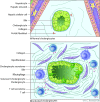Cholangiocytes and the environment in primary sclerosing cholangitis: where is the link?
- PMID: 28733279
- PMCID: PMC5739855
- DOI: 10.1136/gutjnl-2017-314249
Cholangiocytes and the environment in primary sclerosing cholangitis: where is the link?
Keywords: Cholangiocarcinoma; Dietary Factors; Environmental Health; Epithelial Cells; Primary Sclerosing Cholangitis.
Conflict of interest statement
Competing interests: None declared.
Figures




References
MeSH terms
LinkOut - more resources
Full Text Sources
Other Literature Sources
